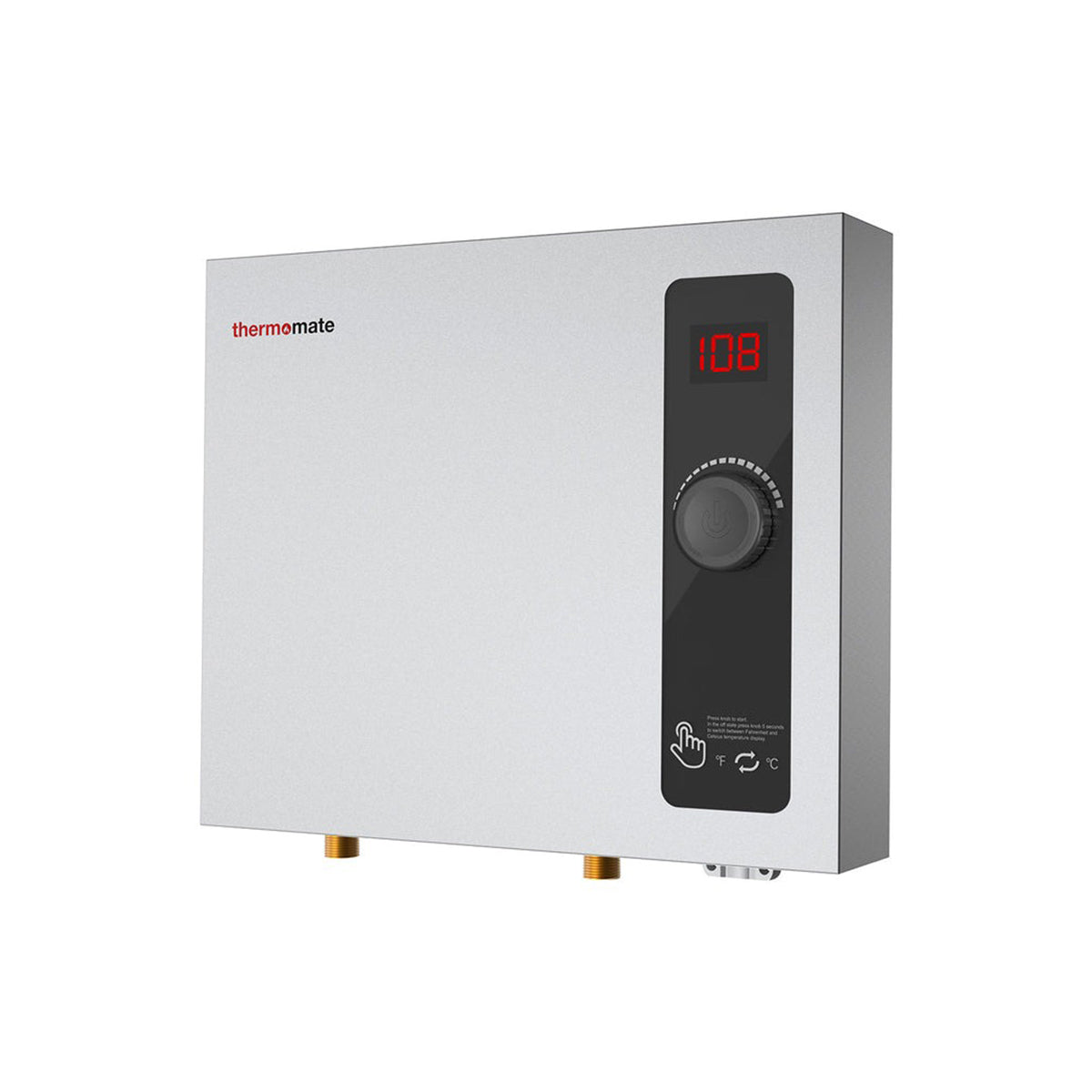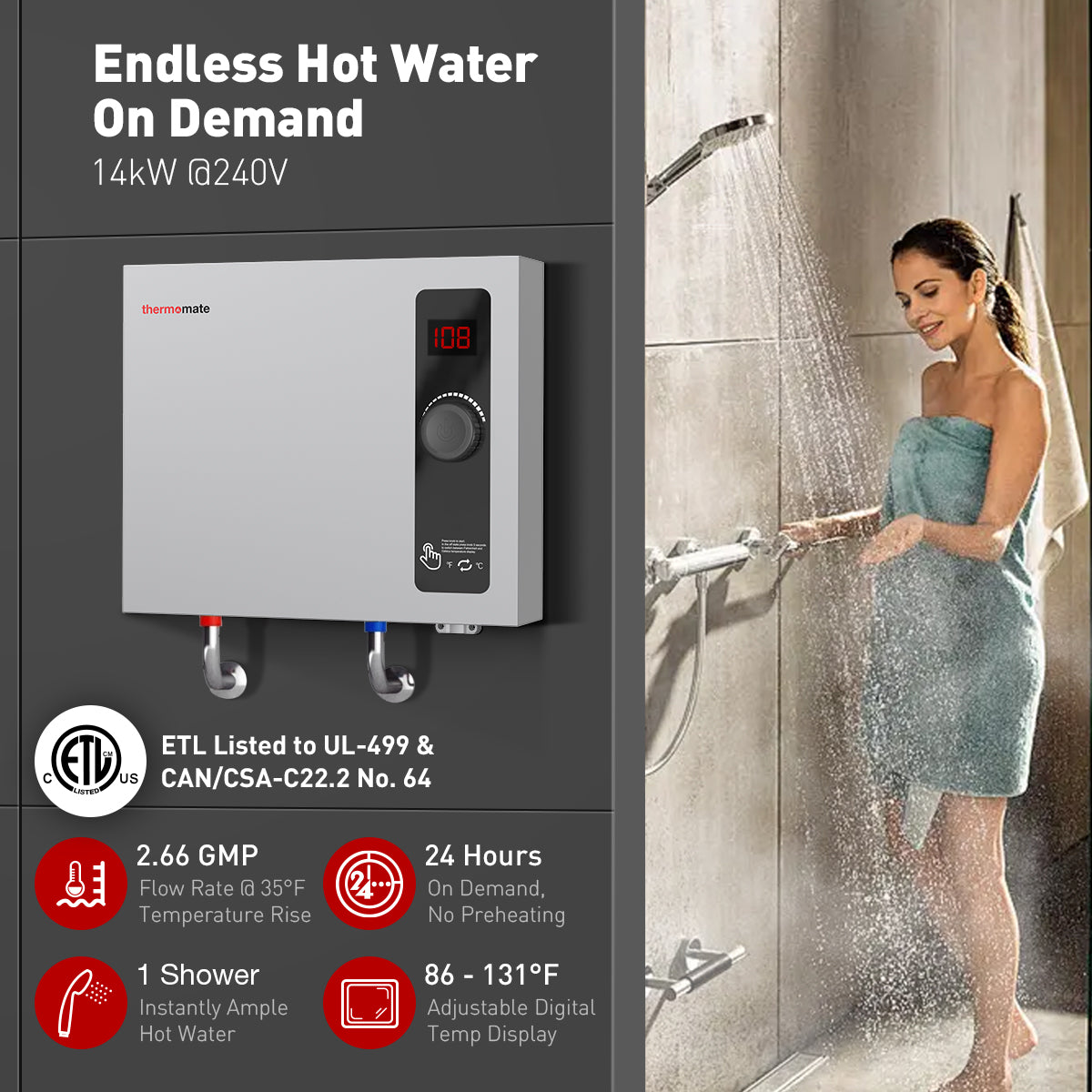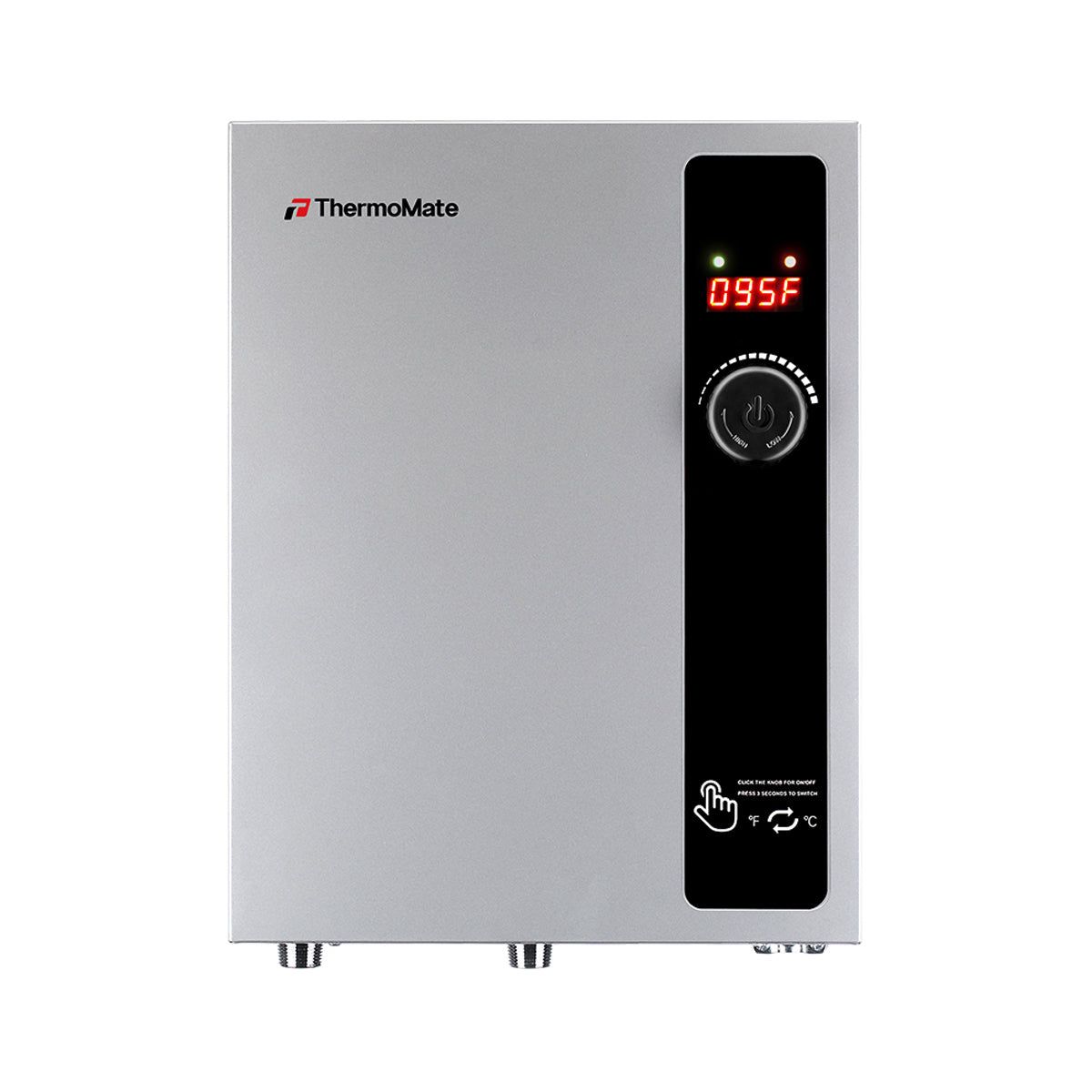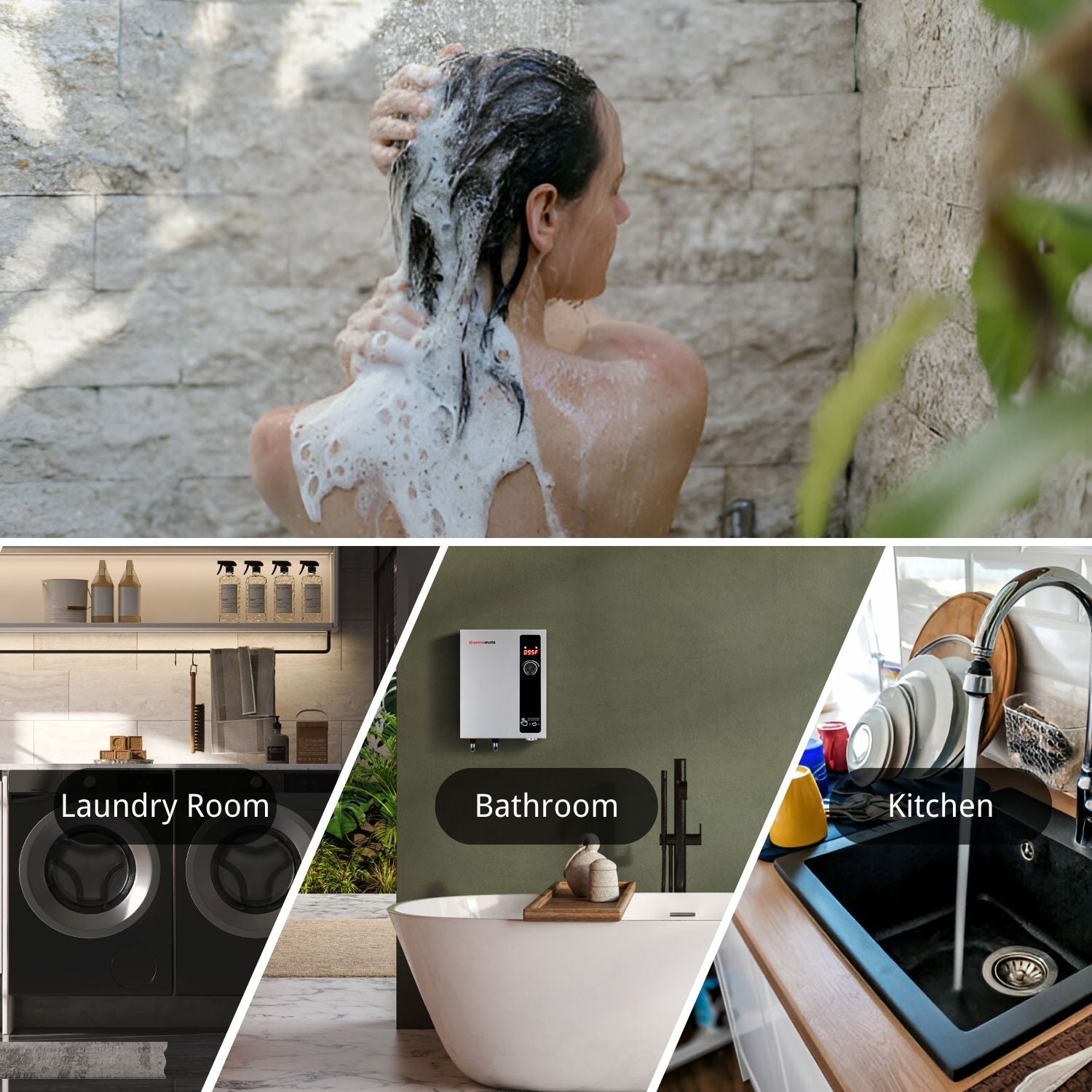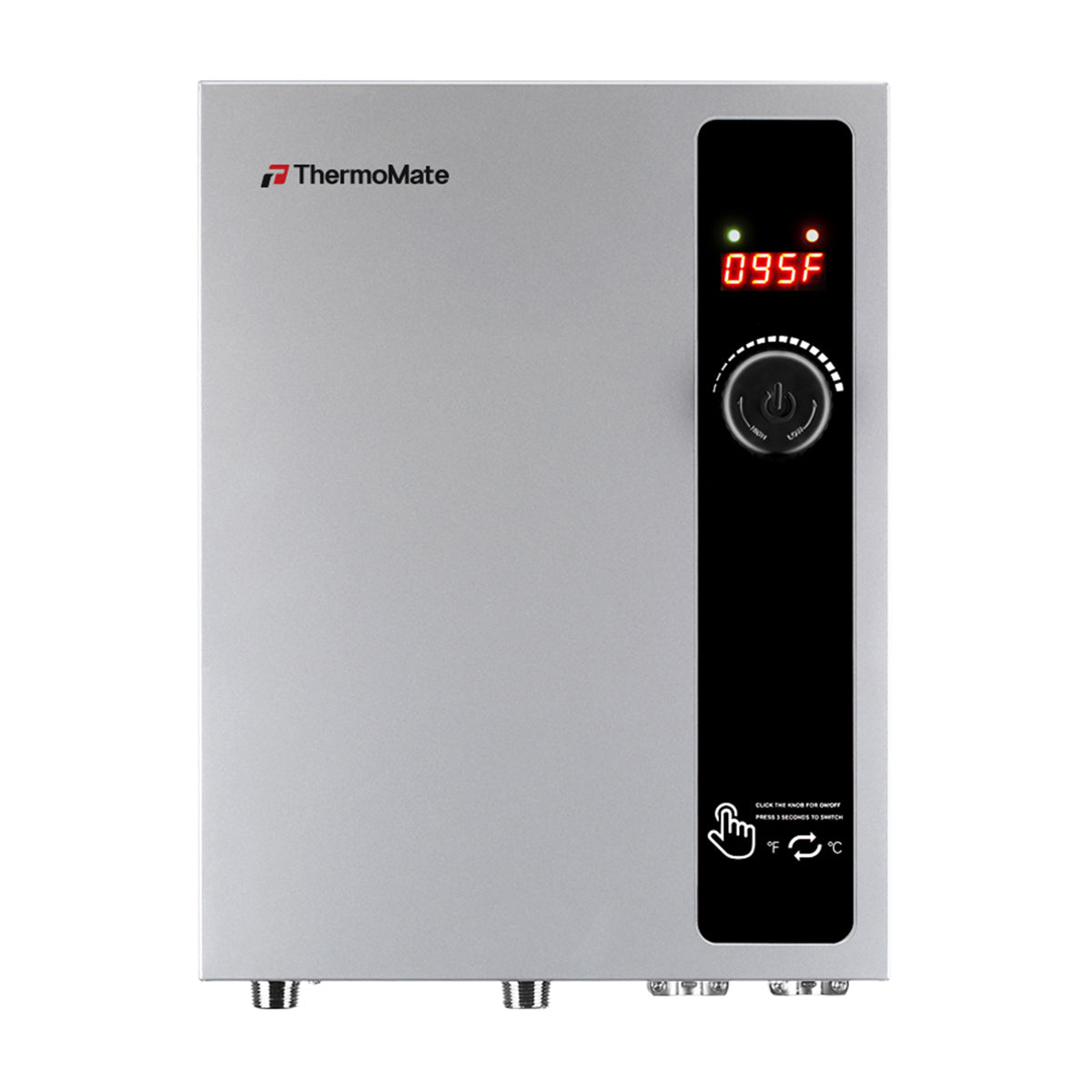You’re taking a hot shower, shampoo in your hair, when suddenly the water begins to turn lukewarm. You rush to rinse, but now the water’s ice-cold and your shower is ruined. Tired of cold-shocking your body when you expect hot water? Well, there’s a way to avoid it, and save money and energy in the process: by installing a tankless water heater.
What Is a Tankless Water Heater?

Tankless water heaters — also known as demand-type, on-demand or instantaneous water heaters — heat water directly, without the need to store water.
A tankless heater has a flow sensing device that is activated whenever a hot water tap is opened. The unit then heats the water using either a gas burner or an electric element and directs the water wherever it’s needed in your home. Since there’s no tank that must be replenished, you don’t have to worry about running out of hot water. Once you close the hot water tap, the unit senses that the flow of water has stopped and shuts off the heating element.
The Pros of Tankless Water Heaters
Long-term Energy Savings
The U.S. Department of Energy reports a tankless water heater is 24% to 34% more energy-efficient than storage tank water heaters—as long as you use around 41 gallons per day. If you use a lot of hot water, around 86 gallons per day, tankless water heaters are only 8% to 14% more efficient since they are running more often. Even up to 50% energy savings is possible if you install a tankless water heater at every location where you use hot water. Compared to a storage-tank water heater, this is a huge improvement.If you install tankless water heaters at each outlet (shower/sink) instead of a centralized system for your entire house, you can save even more; between 27% and 50%.
Saves Money
The main advantage of tankless water heaters is that they are energy efficient and save you money over the long term. Switching from a tank-style water heater to a tankless water heater will save a family of four an average of $100 per year or over $1500 throughout the lifetime of the system, according to Energy Star.
Unlimited Supply of Hot Water
Since tankless water heaters heat cold water to demand, it’s possible to have hot water indefinitely as long as you keep the tap running. While there are some limitations, in theory, a tankless water heater could let you take a hot shower for as long as you’d like without ever getting cold.
Here’s a scenario; you come home from a family beach day and everyone in the house needs to take a shower. By the fifth shower in a row, the hot water is running low, and you’re the one stuck taking a cold shower.

If you have a tankless water heater, you will never find yourself in that scenario. Let me explain.
Each tankless water heater has a maximum flow rate; in other words, they’re only able to heat a certain amount of water at a given time.
If you have 5 showers running simultaneously, most tankless heaters won’t be able to keep up.
However, as long as your water usage at any given time is below the maximum allowable flow rate, tankless water heaters provide an endless supply of hot water.
Since tankless water heaters work by heating water from the external source on-demand, you could take a shower for 10 hours (or longer), and the water would be as hot as it would be for a 10-minute shower.
Note: It is very important to choose the right power according to the water needs of the home. If you don't know how to choose, please see How to Choose a Water Heater?
Saves Space
Not having a storage tank means tankless water heaters are small and thus,if space in your home is limited, tankless water heaters provide a huge benefit.

They are usually mounted to the wall and take up significantly less physical space compared to tank-style water heaters.
Tank-style heaters take up floor space, usually in the basement, while tankless units are mounted to a wall like a circuit breaker and can fit in most closets.
Reduces Risk of Leaks and Water Damage
One of the main risks with mini tank water heaters is that minerals from the hard water can build up in the tank over time, causing corrosion and eventual leaks.
Since tankless water heaters have no tank, there is no risk of leaks or flooding.
That doesn't mean tankless water heaters can't be problematic. They can and will have problems that can cause leaks, but the chances of a large leak flooding the entire basement and causing major damage are slim.
Zero Risk of Tank Exploding
Today’s plumbing code requires all tank-style water heaters to have a temperature and pressure relief valve that opens to release pressure and eliminate the possibility of the tank exploding.
Over time, minerals and sediment from the water can clog up the valve and prevent it from functioning properly.
When this happens, a dangerous amount of pressure can build-up and put you at risk. If you have a tank-style water heater, experts recommend testing the valve at least once a year; learn how in this video.
Although it rarely happens, explosions are a serious risk with tank-style water heaters. Fortunately, since tankless heaters do not have a tank, there is absolutely zero risk of an explosion ever occurring. One less thing to stress out over.
Lower Risk of Burns and Exposure to Toxic Metals
Many experts argue that tankless water heaters are safer than tank-style heaters.
Besides the fact that they don’t have a tank that could explode, they also provide more precise control over the temperature so you’re less likely to be burned by hot water.
Also, as I mentioned earlier, tank-style heaters break down over time due to hard water causing the inner lining of the tank to rust and corrode.Those minerals and particles eventually make their way into your water lines and expose your family to harmful toxins.
Since tankless water heaters don’t maintain a supply of water in a corroding tank, the water they distribute throughout your home is more pure and safer on your skin.

The Cons of Tankless Water heaters
High Upfront Cost of the Unit and Installation
The biggest downside of tankless water heaters by far is the high upfront cost of the unit and installation.Tankless water heats are more expensive primarily due to higher installation costs.
- Often times, special wiring needs to be installed in order to handle the increased load and/or a new vent pipe needs to be installed.

- Also, since tank-style heaters have been around longer and are more common, more professionals are capable of installing them and the labor costs are lower.
- Additionally, hard water (water containing high levels of minerals) can cause tankless water heaters to work harder and eventually break down.
- Due to this risk, some manufacturers require that you also install a water softening system, or the warranty is voided. Installing this additional component adds to the overall cost.
Take Longer to Deliver Hot Water
Another downside to tankless water heaters is the fact that they take longer to generate and deliver hot water compared to tank-style heaters.
When you turn on a hot water tap, the idle water in the pipes is cool or, at best, room temperature.
Once that cool water is flushed out, heated water comes through, however, it can take between a few seconds and a minute depending on the distance between the heater and the tap.
Tank-style heaters don’t produce hot water instantly either but since they have a supply ready to go and don’t need to kick on, it reaches the outlet more quickly.
Cold Water Sandwich
In researching tankless water heaters you’ve likely come across the term “cold water sandwich”.

A cold water sandwich occurs when intermittent use of hot water causes you to feel an initial surge of hot water, followed by cold water, which quickly turns hot again.
When you turn the hot water off and on quickly, like you would when you’re hand-washing dishes, the pipes have hot water in them from moments ago.
The short delay between when the water starts to flow and when the heater kicks on causes a short burst of cold water before turning hot.
The cold water sandwich sensation isn’t a major issue but it can throw you off if you’re not used to it.
Inconsistent Water Temperature When Multiple Outlets Are in Use
The downside is that, if you have multiple showers running at the same time, tankless water heaters are not able to keep up.
This isn’t just a problem with showers, depending on the size&power of your water heater, you can run into issues by having a shower and the dishwasher running at the same time.
Note:when you are shopping for tankless water heaters, the key metric you want to look at is flow rate!
Flow rate is the amount of water that a tankless unit can heat at a given time. It’s measured in Gallons Per Minute or GPM, the higher the GPG, the more water can be heated at the same time.
No Access to Hot Water During a Power Outage
Tankless water heaters can be powered by gas or electricity but even gas-powered tankless water heaters rely on an electric control panel to operate the system.So, regardless of the type of tankless water heater you have, you’ll be out of hot water in the event of a power outage.
This is an area where tank-style water heaters have a significant advantage over tankless. Regardless of the power source, the water stored in their tank will remain hot for several days.

Are tankless water heater good?
If you’re looking for a way to save money long-term, improve your home’s energy efficiency and don’t mind making an expensive investment upfront, a tankless water heater will meet all your needs and more. It’s a great long-term purchase for your home that will leave you wondering why you didn’t make the switch earlier.


